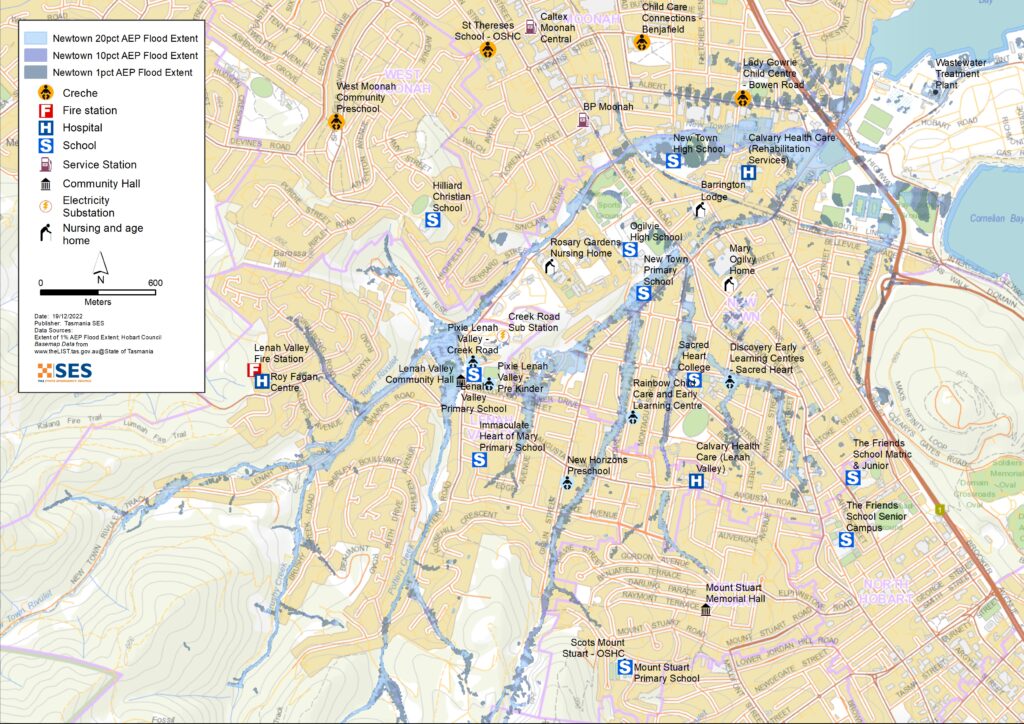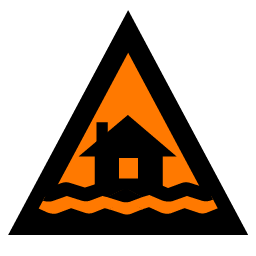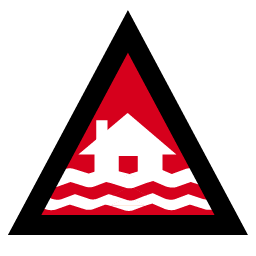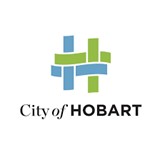Riverine flooding information for New Town Rivulet and its tributaries.

Parts of New Town and Lenah Valley are subject to flooding from New Town Rivulet or its tributaries such as Pottery Creek, Brushy Creek or Maypole Creek. You are likely to experience flooding such as that shown in the map at least once in your lifetime. See Hobart City Council’s flood mapping or Glenorchy City Council’s flood mapping for more detail.
Like most of Hobart, New Town and Lenah Valley are prone to flash flooding so there is often very little warning. As well as riverine flooding, there is also likely to be additional minor flooding caused by stormwater run-off. This can be difficult to predict.
Even if your home is not inundated, you should be prepared for isolation plus potential power and telecommunications outages. Flooding may isolate parts of Lenah Valley for up to 6 hours, depending on the rainfall across Kunanyi/ Mount Wellington.
Travel in the area is likely to be difficult or impossible until roads are clear and safe. In a major flooding event, roads in and around Hobart are likely to be cut as other areas of Hobart are inundated. Traffic is likely to be congested. If you are safe at home or elsewhere, it is usually best you stay where you are until the flooding subsides, unless there is an emergency. If you need to evacuate, you should leave early, before flood waters rise.
Go to tasalert.com.au or listen to ABC local radio 936AM for warnings and advice.
Are you at risk of flood?
Example past flooding events around New Town / Lenah Valley include:
- May 2018 – The Southern Tasmanian Extreme Weather Event caused flooding around Hobart. There was 236mm of rain on Kunanyi/ Mount Wellington.
- April 1960 – About 200mm of rain over 3 days and caused damage across Hobart.
- June 1947 – Two separate flooding events impacted the Hobart area.
What should I do to be prepared?
- Check the map to see whether your home or business is at risk of being flooded. If it is, you should have a plan for leaving during a flood event. During a flood event, go to TasALERT or listen to ABC local radio to find out about evacuation centres or other places to shelter.
- Check if you can safely get to or from your home, work, or school during a flood. If you need to leave during a flood, make sure your route is safe or leave early before floodwaters rise. If you need to evacuate during a flood, make sure your route safe and think about:
- where you would go
- how you could get there
- what you need to take.
- Prepare your home or business to minimise possible flood damage.
- Prepare a Home Emergency Plan.
- If you have a business in the area, you should have a plan that covers flooding. Business Tasmania can help– see www.business.tas.gov.au/manage_a_business/ .
Floods like the one shown in the map or worse will occur again. No two floods are the same.
If you live in a low-lying area or near a watercourse, your house may flood. Even if your home is safe, you may need to detour around flooded areas or your road access may be cut. Never drive into or enter flood waters. Roads and bridges may be washed out or unsafe. Avoid travel during floods.
Knowing what to do can save your life and help protect your property. Having a Home Emergency Plan is one of the best ways to prepare. Decide on weather and rainfall triggers for when to act.
To see map information in more detail, go to the Hobart City Council’s website.
Bureau of Meteorology Forecasts, Warnings, and Observations
The Bureau issues a Flood Warning, Severe Weather Warning and/or Thunderstorm Warning for heavy rainfall that may lead to flash flooding whenever heavy rain is expected in an area. The time between the warning and heavy rain occurring can vary from an hour to 24 hours or more.
Rainfall Observations on Kunanyi/ Mount Wellington can help predict potential flooding in New Town and Lenah Valley, however, the warning times are very short. Hobart’s waterways are prone to flash flooding. Given the very short warning times, you are encouraged to act on the predictive BoM warnings rather than wait for any alerts during rainfall.
The Mt Koonya Radar is useful to be aware in real-time where heavy rainfall is falling. Radar Rainfall estimates can also fill in gaps in areas where there are no rainfall stations.
Flood Warnings are expressed as Minor, Moderate, or Major.
Understand the warnings and key information
Keep aware of what is happening around you. Check forecasts, observations and warnings regularly.
- TasALERT.com
- your local ABC radio station or
- the Bureau of Meteorology’s website.
 | Advice (Yellow): an incident has started. There is no immediate danger. Stay up to date in case the situation changes. |
 | Watch and Act (Orange): There is a heightened level of threat. Conditions are changing and you need to start taking action now to protect you and your family |
 | Emergency Warning (Red): An Emergency Warning is the highest level of warning. You may be in danger and need to take action immediately. Any delay now puts your life at risk. |
 | Community update (Blue): Specific information and updates for affected communities regarding a particular event or incident. |
| Incident (White): an incident is the initial occurrence of an event before it becomes an emergency warning. As soon as an incident is reported, TasALERT published basic information including the type and location of incident. |
Flood levels in New Town and Lenah Valley
While no two floods are the same, the following table shows what you can expect at different flood levels around South Hobart. Even if your property is not flooded, you need to think about access. The example rainfall to cause such an event is an example: other levels of rainfall can cause flooding depending on its intensity, duration and how wet the ground is beforehand and where the rain falls.
A Minor Flood (less than 20% chance of happening in a year (Annual Exceedance Probability – AEP)
For example up to about 50mm over 6 hours on Kunanyi/ Mount Wellington
As reclaimed land, parts of Lower Risdon Road/ the lower end of Albert Rd and the playing fields around Cornelian Bay, Queens Walk Oval and surrounds may be inundated. Use alternate routes.
Walking tracks along rivulets may become inundated.
A Moderate Flood (from a 20% and below a 1% chance of happening in a year)
For example about 50-80 mm in 6 hours on Kunanyi/ Mount Wellington
Low lying areas become inundated along waterways. Water may be above floor heights for some properties in areas such as
- Augusta Rd
- Forster St intersection with New Town Rd and near Valentine St
- Bellevue Parade
- Further areas of Risdon Rd
- Lower Lenah Valley Rd
- Kiewa Rise
- Valentine St
- Pedder St and Cross St
- Mercer St cul de sac
Hobart City High School New Town Campus and New Town Primary School grounds likely to be inundated
There is likely to be water on many routes – see maps for details.
A Major Flood (a 1% chance or less of happening in a year in the current climate)
For example more than 80 mm in 6 hours or more on Kunanyi/ Mount Wellington
Those areas inundated in moderate flooding events will have higher water levels, above floor level in many cases. Further areas are likely to experience flooding and properties in these areas with low floor levels are likely to be impacted. Please refer to the maps for details on specific areas.
Some areas may become isolated for some hours, including Lenah Valley Road and surrounds.
Unless there is an emergency or you are not safe where you are, you should shelter where you are during a flooding event. Floods around Hobart rarely last more than a few hours. Traffic is likely to be very congested. Listen to ABC local radio or go to TasALERT for advice.
Know your risk, get ready, reduce risk where you can, connect with others, stay alert and act safe.
Before a flood
1. Know your risk
Flooding often happens in Tasmania and can cause widespread and significant damage. In the past 200 years there have been 78 flood related deaths in Tasmania. This guide is to help you understand flood risk in your area.
2. Prepare your household
Have an emergency plan that covers storms and floods
Thinking about what you would do in a storm or flood means you are more prepared and everyone is safer. Have an emergency plan that everyone in your household understands. There are checklists to help you think through your plan – see the SES website or Red Cross Rediplan.
Check your plan regularly and test it by everyone in the household thinking through a flooding scenario that may affect your household.
Prepare an Emergency Kit
Ready to Go
Battery powered radio and torch, spare batteries
Important information, such as your emergency plan
A list of emergency numbers
Food and water
First aid kit
Rubber or strong leather gloves
Pack when needed
Warm clothes, sturdy shoes or boots
Medicine, glasses or other essential items
Mobile phone and phone charger
Pet food and anything else they need
Photos and special keepsakes
Important documents, for example
– insurance papers
– passports and
– birth certificates
Regularly test batteries in radios and torches.
3. Reduce your risk from flooding where you can
- Think about storms, flooding and other hazards when buying, maintaining or developing property.
- Trim or remove trees and branches overhanging your home, business or near powerlines on your property.
- Keep your gutters and drains clear.
4. Connect with others
Know your neighbours and get involved in your community. A connected community is a safer and more resilient community in an emergency and can help everyone recover better afterwards. Check that family and neighbours are safe and aware of what’s happening.
During
5. Keep up to date
Keep aware of what is happening around you. Check forecasts, observations and warnings regularly.
- www.TasALERT.gov.au
- your local ABC radio station or
- the Bureau of Meteorology’s website.
6. Act Safe
- Supervise children.
- Prepare for possible power, water or internet outages.
- Check your emergency kit is ready to go.
- Keep clear of flooded areas such as drains. NEVER walk, play, ride or drive in floodwater. You can’t always see what is under the water or how deep or fast-moving the water is. It is easy to be swept away and drown in as little as 20cm of fast-moving water. Flood water can be dangerous.
When your home may be flooded
- Put household items up high to minimise possible damage.
- Turn off the electricity and gas if it is safe to do so.
- A great way to stop sewerage flowing back into your home is to place sandbags inside plastic bags and use them to block toilets and cover drains and sinks.
- Leave while you can get out safely.
If you need to evacuate
- Follow the advice from SES / Tasmania Police.
- Take your emergency kit.
- Go to friends or family in a safer place or an evacuation centre.
- Let others know where you have gone.
Look after your animals
You are responsible for your animals in an emergency. If you have pets and other animals it will take you longer to evacuate in a flood or other emergency. Move livestock from flood prone areas well before flood waters may rise. For more information see
- RSPCA’s guidance on preparing for animals in an emergency
- Huon Valley Council’s advice on preparing an emergency pet plan
- the Primary producer farm flood readiness toolkit
Avoid travelling during and after storms
- Do not go sightseeing. Sightseers delay emergency services and cause accidents.
- Watch out for hazards such as
- water over roads
- damaged powerlines
- landslides
- damaged roads
- falling trees or roofing iron.
- Never drive through flood waters. Most deaths and rescues in floods are from people driving through flood waters.
- Drive slowly and turn your headlights on roads not affected by flood waters.
After
- Keep listening for ABC Local Radio updates, road re-openings, community meetings, etc.
- If you left your home, do not return home until SES or Tasmania Police tell you it is safe to do so.
- Be aware of road hazards, such as mud or debris on the road, damaged roads/bridges and crews working on clean-up and repairs.
If your home has been damaged
- Stay at ground level while checking for damage. Be careful of fallen trees, broken glass, loose roofing or other hazards.
- Wear strong boots, gloves and protective clothes.
- Use a torch, never use matches or candles inside flood affected buildings.
- Boil all drinking water until you are told the tap water is safe again.
- Do not turn on it is tested by a licensed electrician or gas fitter for safety.
- If your home is damaged and you need to stay somewhere else, take your emergency kit and pets with you
- Take photos of any damage if safe for you to do so and contact your insurance company.
- Supervise children.
- Check neighbours are okay.
For further information go to www.ses.tas.gov.au
Staying informed and further information
Current warnings (TasAlerts) alerts.tas.gov.au
Bureau of Meteorology bom.gov.au/tas/warnings
Emergency Broadcasters ABC 936AM
TAS SES Social Media
- facebook.com/sestasmania
- twitter.com/sestasmania
SES – Preparing for Flood Emergencies
Hobart City Council ph 62382711


